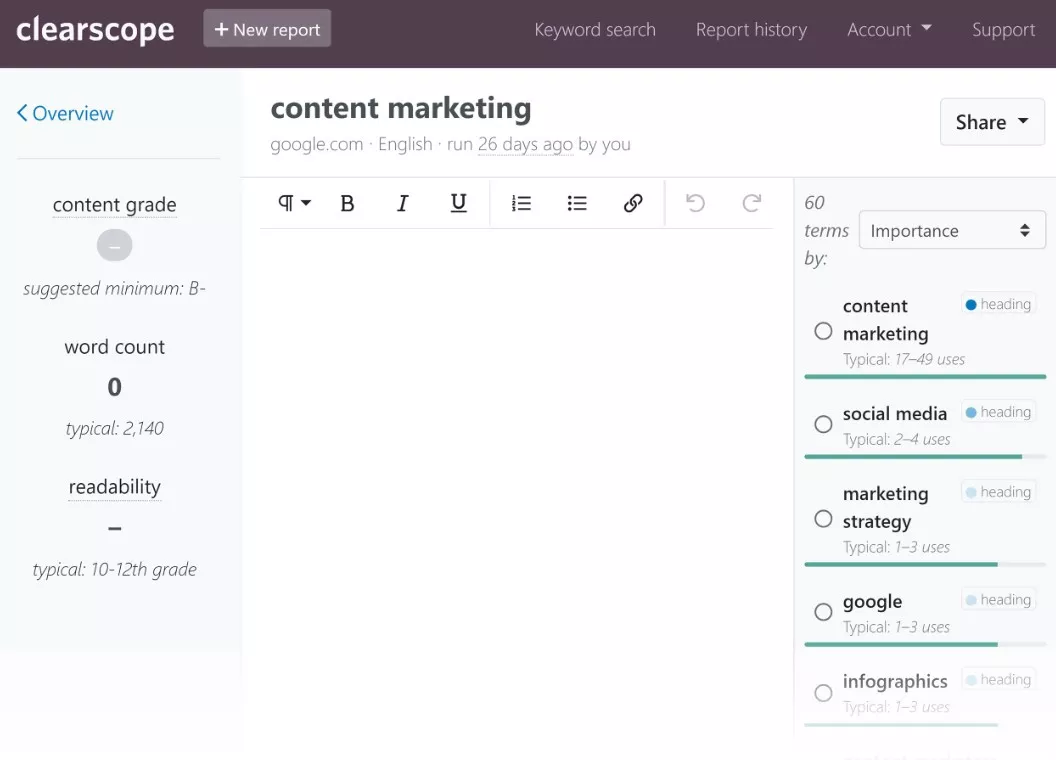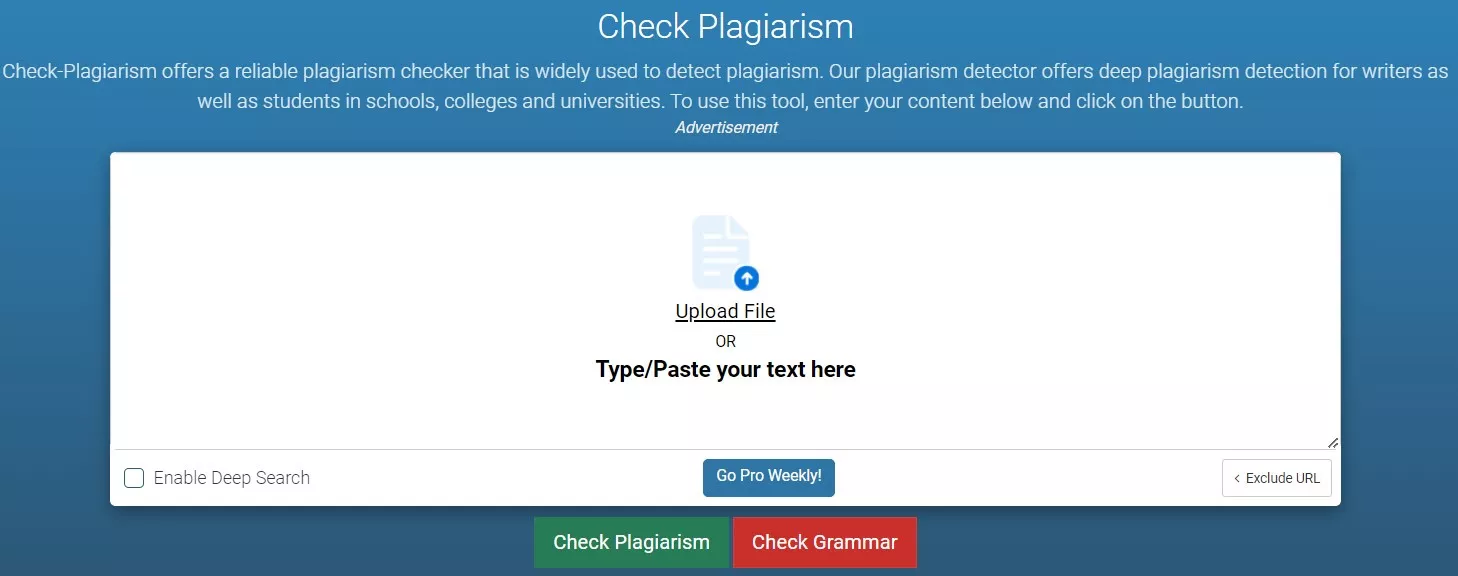Content is one of the key website pillars that can make or break your rankings. It can increase your website’s visibility and drive many new visitors organically. Content helps you naturally increase your brand awareness and leave the competition behind.
Writing content that outperforms the competition and thrives in search results requires some key practices. Here are some effective and useful tips that will enable you to strengthen your content creation process.
Tip 1: Get ideas from your competitors’ content
The very first step before you start writing is to choose the topics you want to cover on your website. Don’t write about topics that only interest you. Try to discover the topics your target audience likes to read or search about.
The best practice is to:
1. Visit your competitors’ websites and perform a deep content analysis using content analysis tools like Clearscope. This will help you determine what topics helped them rank higher and how they covered those topics. For instance, find out their targeted keywords, analyze the depth of their content, examine the overall structure, and find loopholes. Then, use this information to create better content; it can help you rank higher against your selected keywords.
2. Make a list of the top topics that drove sufficient traffic to your competitors and save it for content creation.
Content analysis will also help you discover content gaps on competing sites and cover those gaps to gain more traffic. For instance, if your competitors completely ignore a few relevant hot topics, make a list and create content on those topics. This practice will surely help you attract more visitors from search engines.
Discover key content marketing definitions in our glossary to elevate your strategy!
Tip 2: Make sure your content is unique
Originality is one of the most important factors in quality content. Search engines will not promote unoriginal content. In fact, it will lower your site’s reputation and visibility.
You can get ideas from other people’s content, but don’t copy and paste it exactly or partially. This indicates your intellectual dishonesty, which search engines penalize. So, keep your content free of duplication from beginning to end and present the topic in your own words.
To ensure that your content is free of duplication, you can analyze it manually or run it through an online plagiarism checker. It accurately highlights any copied content, eliminating the need for manual review.
Tip 3: Keep your content reader-friendly
Readers who find content difficult to read become frustrated and disappointed. As a result, engagement rates will decrease, and all your content creation efforts will be in vain.
- Before writing each word, consider whether it will improve readability.
- Keep sentences short and easy to read for the convenience of the reader.
- Avoid using hard words, technical terms, and slang.
- Avoid repetition of words and phrases. This can make it difficult for readers to understand the main purpose of the content.
- Use enough transitional words like however, again, therefore, such as, overall, etc., to make all sentences coherent.
- Try to present your words in an active voice. For example, the sentence “the teacher explained the concept” is much simpler and easier to understand than its passive voice, “the concept was explained by the teacher.”
Tip 4: Provide value to readers
Top-ranked content always includes in-depth and practical knowledge that provides value to the readers. Don’t fool them by providing only general information.
To show readers that you care about them, research the topic thoroughly and include helpful facts, figures, and insights in your articles. This will increase the clarity and authenticity of your content, which will help you gain their trust.
Once you do this, your site’s engagement rates will increase dramatically. It will signal to the search engine that your content is helpful, and the search engine will begin to rank the content organically.
Tip 5: Implement basic SEO practices
Along with making content readable for the audience, making content easy to scan for search engines is also essential. The SEO-friendly content more quickly gains higher positions on search results. Therefore, optimize the content using basic SEO techniques.
- Properly organize the content’s information using header tags and ensure you use them chronologically. That’s how you can create logical order, make content more understandable, enhance visual appeal, and, most importantly, improve user experience.
- Add internal and external links that drive users to high-authority pages to make the search engines recognize that your content is credible. For example, provide links to related articles on your site that provide additional information. Also, add external links to high-authority websites to signal that your articles are well-researched.
- Remember to optimize graphical content such as images, infographics, or illustrations. Choose the right format, optimize sizes, add alt text and captions, and customize file names. For instance, if you want to add an infographic to your site, choose PNG format, compress file size, add the right alt tags to improve its visibility, write captions to provide additional details, and use the keyword-rich file name.
- Keep the meta title brief, elaborative, and attention-grabbing. For example, if you have written a blog post about gardening tips, write a meta title: “Expert Tips to Grow a Stunning Garden at Your Backyard.” This meta title has everything you need to attract visitors searching for this type of information.
- Place the keywords where they make sense because this helps search engines understand the overall context and realize how helpful it is for users. For instance, you can add them to the title tag, headings, meta description, body, and image alt text. Consequently, crawlers will quickly understand what your pages are all about and rank them against specific queries.
To make sure all these elements work together and nothing critical is overlooked, consider running an In-depth Technical SEO Audit. It will help uncover hidden technical issues and ensure your on-page efforts have maximum impact.
Wrapping up
Writing search engine-friendly content is an important process.
- You have to combine different writing elements to create an article that ranks well.
- This includes creating in-demand topic ideas and making the content unique, readable, and authentic.
- Optimizing the content by applying basic SEO techniques increases the chances of ranking.
The opinions of the authors of the guest posts may not reflect the position of the editors and specialists of Netpeak Agencies Group.
Related Articles
How to Set Up Consent Mode in GA4 on Your Website with Google Tag Manager
Let's explore how to properly integrate consent mode in GA4, configure it for effective data collection, and at the same time comply with GDPR and other legal regulations
Display Advertising Effectiveness Analysis: A Comprehensive Approach to Measuring Its Impact
In this article, I will explain why you shouldn’t underestimate display advertising and how to analyze its impact using Google Analytics 4
Generative Engine Optimization: What Businesses Get From Ranking in SearchGPT
Companies that master SearchGPT SEO and generative engine optimization will capture high-intent traffic from users seeking direct, authoritative answers





